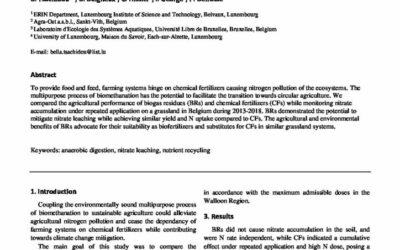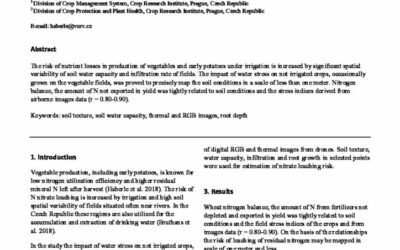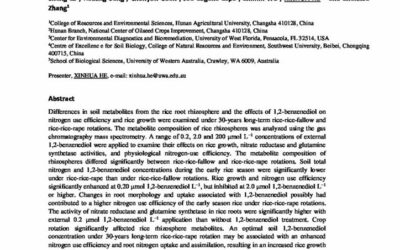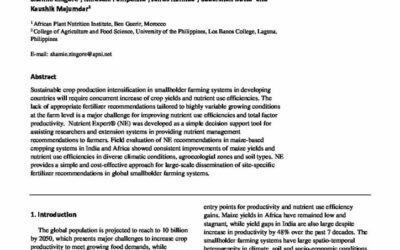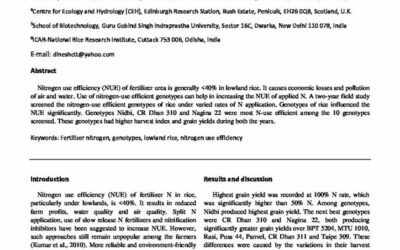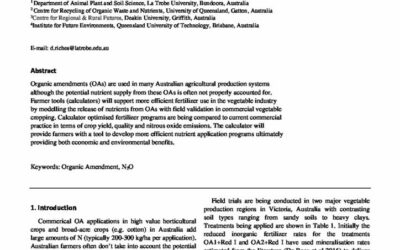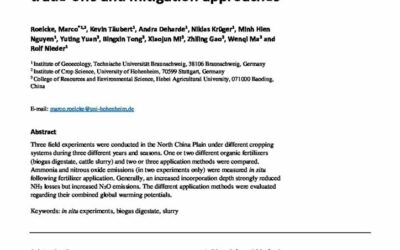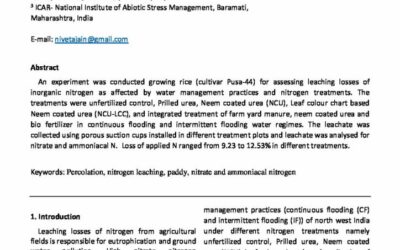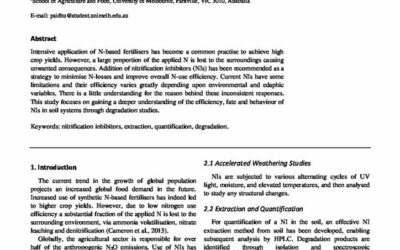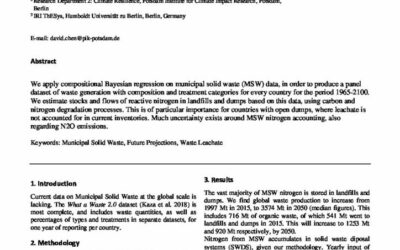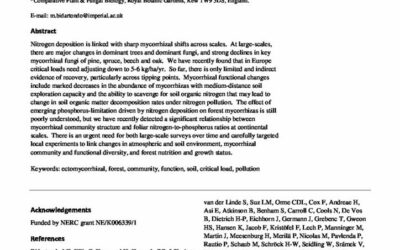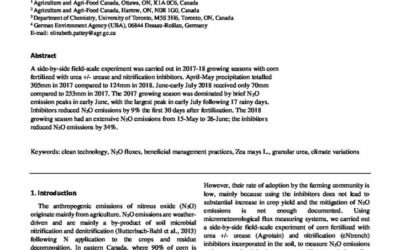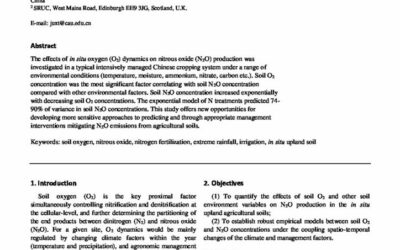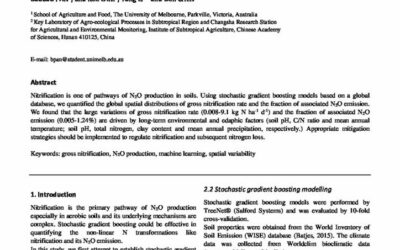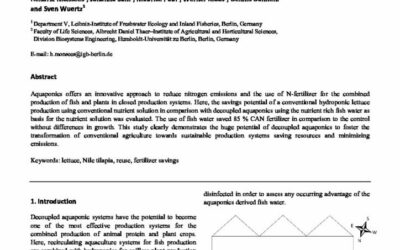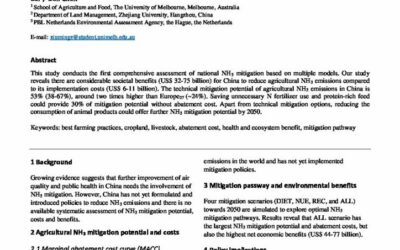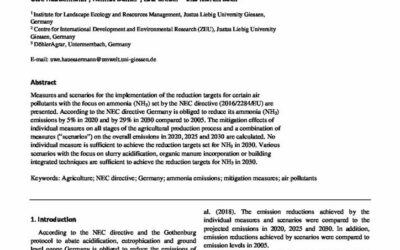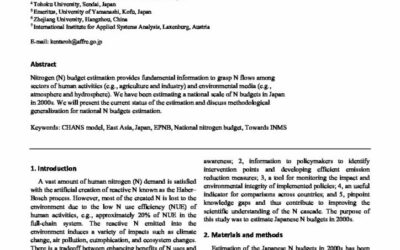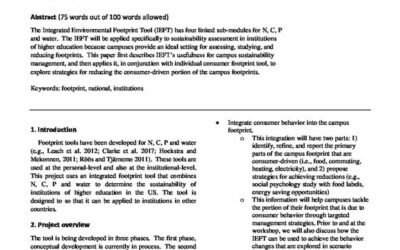Abstracts for INI2021
Key-Note Session Day 1
Improving plant NUE: From phenotype to genotype
Lack of well defined phenotype and genotype have hampered crop improvement for N use efficiency so far (Raghuram and Sharma, 2019). We ranked 21 rice varieties (Indica) based on N-responsive germination and...
New Trends in Nitrogen Management: Africa Perspective
The paradox of “low N” regions vs “high N” is valid for Africa (Sutton et al., 2013). The Melbournedeclaration (December 2016) on responsible N management for a sustainable future affirmedimprovement in use...
Ecological intensification – new approaches to increase nitrogen use efficiency in dairy farming
The recent intensification in European dairy production has raised environmental and sustainability questions about the current housed systems. Pasture is considered to be the cheapest forage but its role in...
A vision for future nitrogen management
Nitrogen management needs to progress immensely over the coming decades if humanity is to return to a safe planetary boundary. This requires innovation in technology to develop more site-specific management...
Nitrogen: of planetary importance for Earth resilience
Human societies depend on the stability and resilience of the Earth system, and now undermine this stability by radically altering planetary biogeochemical cycles. The cycles of nitrogen and phosphorus underpin healthy...
Key-Note Session Day 2
Digital Agriculture and Nitrogen: Science, Implementation, and Policy
Gains in nitrogen use efficiency in crop production remain low due to management complexities and perceived divergent economic and environmental incentives. Digital agriculture technologies can move the industry...
Key-Note Session Day 3
Nitrogen – Friend or Foe of Soil Organisms?
Soil is the living skin of the earth. Soil is also the largest pool of organic matter on land. The turnover of this organic material is governed by the most diverse community of earth, the soil organisms, whichregulate...
How increased nitrogen availability has influenced biodiversity
Nitrogen deposition has had widespread impacts on plant communities in Europe and North America, reducing species richness of many different habitats and changing plant species composition. There changes have been...
Nitrogen and water pollution in China
Food security and the nitrogen-flow pattern in China have been radically changed in the past 60 years. The traditional agricultural systems, which were mainly relied on recycling organic waste, are considered...
The history and future perspectives of Baltic Sea Eutrophication
This presentation illustrates the past and present situation in the Baltic Sea with an outlook on future development. The semi-enclosed and highly stratified Baltic Sea has intermittently experienced anoxic...
Key-Note Session Day 4
N matters – the art of risk communication
Stinking manure on the fields, clouds of yellow smoke set free from chimneys. Easily recognized challenges mainly cause quick answers but rarely sustainable solution. Communicating about N is a tricky task: at least in...
Managing Nitrogen for sustainable agriculture production
Human alteration of the global nitrogen cycle by agricultural activities has provided nutritious food to society, but also poses increasing threats to human and ecosystem health through unintended pollution. Managing...
Opening Sessions
Fritz Haber (1868-1934): Life, Work, and Legacy
Fritz Haber's discovery of the catalytic synthesis of ammonia from its elements may serve as an apt reminder of the Janus-face of modern science: On one side, "bread from air," on the other, "gunpowder from air."...
2b, 4a, 5a – Nitrification and Inhibitors
Root system architecture variability and nitrate reductase activity in wheat genotypes for nitrogen use efficiency
Selection of nitrogen (N) efficient genotypes based on N assimilating enzymes and root architectural traits are among the strategies to achieve improved nitrogen use efficiency (NUE). Twenty wheat genotypes were...
Effect of elevated atmospheric CO2 on the quantities and communities of microbes
Elevated atmospheric CO2 concentration (eCO2) has been the most driving factor and characteristic of climate change. To clarify the effects of eCO2 on the soil microbes and on the concurrent status of soil carbon and...
Effect of nitrification inhibitors and soil pH on N2O emissions
Continued N addition in agricultural soils leads to soil acidification, which affects crops yield and soil nitrification and denitrification processes. Liming is the most common strategy to reduce soil acidity. A...
Identification of a new N‐heterocyclic core structure with nitrification inhibition activity in Australian soils
Nitrification inhibitors (NIs) can be utilised to reduce nitrogen losses and environmental implications of synthetic fertilisation. However, current commercial NIs provide variable results under Australian field...
Assessment of the efficiency of nitrogen removal from municipal wastewater
One of the biggest risks to surface waters is the deterioration of their quality as a result eutrophication. The main sources of nutrient loads causing eutrophication are agriculture and municipal wastewater. In small...
1b. Responsible consumption and production and feedbacks in the N cycle
Physiological Nitrogen release from human population
Human population living in rural areas with no sanitation might be considered as N pollution source not only due to its Nfootprint, but also via direct physiological N release. We found that in the region of Prut and...
Nutrient-extended input–output analysis for food nitrogen footprint
Nitrogen (N) inputs to agro-food systems are ultimately lost to the environment and threaten human and ecosystem health. We developed and applied a novel approach—the nutrientextended input–output (NutrIO) analysis—to...
Assessing future nitrogen fertilizer demand
Inefficiencies in global cropland nitrogen use have led to the dissemination of reactive nitrogen throughout the hydrosphere. Assessing the future N input requirements and N use in agriculture for the five shared...
Evidence-based Nitrogen Indexes for Sustainable Agriculture
Reactive nitrogen (Nr) is essential for agricultural production and human nutrition, but also leads to Nr pollution. Nr pollution induced by food are created by millions of diverse producers/products worldwide with...
Sustainable food systems from a nitrogen perspective
Only if addressing food systems in a holistic and comprehensive way will be enable toovercome the multiple failures of high environmental impact from food production andconsumption and health effect through under- or...
The groundwater diet: trade-offs and benefits
Effects of dietary choices on groundwater pollution are often not considered in the context of sustainable and healthy diets. We used a large dataset of the National Minerals Policy Program of the Netherlands to gain...
2a. Livestock production and nitrogen Balance and nutrient cycle
P budget calculations of German farmland and resulting manure surpluses in livestock hotspot regions
The agricultural sector in Germany is characterized by regionally spezialised managing systems. Livestock and biogas production is concentrated in the northwest and the south east regions, resulting in locally high...
Optimising N recovery from livestock waste for multiple production and environmental benefits
Intensive dairy, beef and poultry industries share the common practice of housing animals through all or part of their productive life. This leads to a concentration of animal waste, high nitrogen (N) loss, detrimental...
Assessment of nitrogen flows at farm and regional level when developing the manure management system
The nitrogen flows on large-scale livestock enterprises in Leningrad Region were considered to determine how to take integrated manure management decisions towards reducing the nitrogen losses and, consequently, the...
High animal comfort and low emissions in a new housing system for pigs
The objective of the DBU-funded project "Pig farming without FYM and slurry" is the development of a pig farming system which, on the one hand, significantly reduces environmentally and climate-relevant emissions and,...
Long-term measurement of ammonia and nitrous oxide emissions
One of the major issues facing the Australian beef feedlot sector’s drive to carbon neutrality by 2030 is the lack of robust long-term greenhouse gas (GHG) emissions data. Here we present part of our work at two...
Effects of lime application management on nitrous oxide emission
Here we present the annual nitrous oxide (N2O) emissions from a medium-term grassland trial established in Wexford, Ireland. The objective was to investigate the link between N2O emissions and a range of soil pH levels...
Effect of nitrogen-reduced diet on NH3 and N2O emissions of dairy cows
The NH3 and N2O emissions from two parallel pasture-based feeding systems with dairy cattle were measured. In one system cows were fed exclusively on pasture grass, in the other system 25% maize silage was...
Sources of nitrous oxide from intensively managed pasture soils
High N-inputs render pasture soils prone for N2O emissions produced via multiple microbial pathways. Their contribution to N2O production remains however unknown at various scales leading to uncertainty within models...
Integrated Nitrogen Balance in Livestock Sector
The livestock sector in Latvia is one of key sources of reactive nitrogen emissions, by nitrogen leaching to hydrosphere, ammonia and nitrous oxide emissions to atmosphere. The aim of this study is to develop the...
An integrated approach to nutrient management on dairy farms
We describe a novel experimental approach to assess the integrated effects of a suite of innovative measures for improving nutrient efficiency of dairy farms. The approach uses four semi-virtual farmlets, representing...
Influence of soil properties on N2O emissions
Observations on nitrous oxide (N2O) from urine and dung patches deposited by grazing cattle in sub-Saharan Africa (SSA) are scarce. Moreover, the effects of soil properties (e.g. pH or texture) on N2O emissions from...
2b. Optimizing the efficiency of nitrogen use in crop production
Comparing yield, nutritional quality, water and nitrogen use efficiencies of deficit drip and flood irrigated sorghum
Drought conditions have mandated that California growers use low quality groundwater resources for irrigation of forage crops. In the current study we compare the Nitrogen and Water Uses Efficiencies (NUE and WUE) of...
Delayed N timing for maize reduced N2O emissions and drainage [NO3 – ] while increasing yield
Traditional farmer practice in the central U.S. is to apply all N fertilizer before planting maize. Two long-term experiments (11 and 6 years, respectively) resulted in substantial yield benefits (30% and 13%,...
Exploring the Impact of Nitrogen Sources on Yield, Partitioning and Nitrogen Use Efficiencies
The nitrogen use efficiency (NUE) by crops in sub-Saharan African cropping systems is relatively low as a result of low Nitrogen (N) inputs and high N losses, posing both economic and environmental concerns. In rice...
Nitrogen and water use efficiency of maize in long-term field experiment
The aim of the study was to characterize the productivity of maize for grain, fertilized with nitrogen rates 50- 250 kg N·ha-1 depending on its nitrogen and water use efficiency. It was found, that grain yields of the...
Wheat productivity at various Nlevels and future predictions under changing climate
Food security and sustainability need appropriate nutrient management and timely sowing of wheat crop under changing climate. Field trials were conducted to assess nutrient and water productivity for wheat in irrigated...
Nitrogen use efficiency in long and short-term experiments of the Russian Federation
A study of the efficiency of nitrogen utilization by winter wheat on the basis of databases of long and short-term experiments with fertilizers located in the Non-Chernozem zone of the Russian Federation and in the...
Land preparation and maize-based multiple cropping on nitrogen content in two agroecologies
The study was conducted in two agro ecologies (rainforest and derived savanna) of Nigeria to determine maize grain yield and nitrogen (N) content under different land preparation (conventional plough and traditional...
Algae extracts as a sustainable nitrogencontaining fertilizer
The enormous increase in the world population will provoke an escalation in our overall consumption and demand for food and animal feed, which will eventually drain our limited resources. Therefore, increasing...
Biogas Residues in substitution for Chemical Fertilizers
To provide food and feed, farming systems hinge on chemical fertilizers causing nitrogen pollution of the ecosystems. The multipurpose process of biomethanation has the potential to facilitate the transition towards...
Nitrogen recycling in mango orchards from litterfall and pruning biomass
Mango production systems in the NT require low nitrogen (N) inputs, with excess applied N having negative impacts on fruit quality. Crops remove ~0.85 kg N t-1 of fruit harvested, or 13-20 kg N ha-1 . Potential...
Urease inhibitor still active at low concentration
Urease inhibitors (UI) decrease NH3 volatilization losses but the degradation of UI after urea storage reduces its effectiveness. Urea coated with UI (550 and 733 mg NBPT+NPPT kg-1 urea) stored at 20°C and 30° for up...
Effect of urease and nitrification inhibitors on N2O emissions, ammonia volatilization and crop yield in a rape crop
A field experiment was conducted in an Oilseed rape (Brassica napus L.) crop in central Spain. We evaluated three different fertilizer treatments: conventional fertilizer (urea), fertilizer with urease inhibitor and...
Effect of application rate on nitrogen fertilizer recovery in an irrigated cotton cropping system
Irrigated cotton in Australia on heavy textured clay soils (Vertiol) is typically described as inefficient with respect to nitrogen, due largely to significant gaseous N losses through denitrification. We investigated...
Effects from plant type and glyphosate application on mineralization of nitrogen from catch crops
Plant residue decomposition plays a vital role in soil fertility and nitrogen leaching in agriculture, especially in connection with the use of catch crops between main crops. A low temperature incubation experiment...
Nitrogen use efficiency of maize and cotton in 1.32 Mha of commercial farms in Brazil
We used data from 2011 to 2019 of cotton and maize yields and N fertilization of 4,519 commercial fields covering 1.32 Mha in Brazil to calculate nitrogen use efficiency (NUE), N export with grains and lint+seeds, and...
Indices of crop water stress from UAV images precisely map residual nitrogen
The risk of nutrient losses in production of vegetables and early potatoes under irrigation is increased by significant spatial variability of soil water capacity and infiltration rate of fields. The impact of water...
Gaseous nitrogen losses from a subtropical sugarcane cropping system
Sugarcane is typically produced under conditions that are known to stimulate gaseous nitrogen losses via denitrification. These losses illustrate a highly inefficient use of N fertilisers on sugarcane farms but total...
Changes in nitrogen agricultural practices to increase farm sustainability – tomato production
Abstract Nutrients, namely nitrogen, are essential to crop growth. Efficient nitrogen fertilization was tested in processing tomato plants with and without mycorrhizae, in the field. Mycorrhizae presents an alternative...
Impact of N-fertiliser reduction on agronomic parameters and quality aspects for drinking water production
Many groundwater bodies in Northwest-Germany suffer from nitrate leaching in regions with high livestock densities. In Belm-Nettetal (Lower Saxony) farmers have to reduce the nitrogen (N-)fertilisation by 10/20% in...
Long-term nitrogen fertilization can increase the availability of residual phosphorus in arable soil
The agriculture in the Czech Republic has been characterized in the past thirty years by a reduction of 37% in basic fertilization with organic fertilizers, basic fertilization with phosphorus and potassium (a...
The GxExM interaction and effect on nitrogen uptake in Australian cotton
The interaction of genetics, environment and management and the effect on nitrogen uptake (kg N/ha) was investigated using Bollgard® 3 variety - Sicot 746 B3F. Cotton plants were sampled from first flower to maturity...
In-situ real-time NIR monitoring of nitrogen in irrigated cotton northern NSW, Australia
Achieving optimum yield in cotton (Gossypium hirsutum L.) requires pre-season soil nitrogen analysis and frequent in-crop monitoring. The current agronomic protocol requires petiole sampling at 3 critical stages during...
Predicting N status in maize with clip sensors: choosing sensor, leaf sampling point, and timing
Adjusted N fertilization is a key factor to increase N fertilizer efficiency and chlorophyll leaf clip sensors can help to improve it. This study tried to identify the ability of two different devices for maize N...
Sensitivity of hyperspectral bands to N concentration at different growth stages in winter wheat
Spectral indices are a precision tool to increase nutrient use efficiency by estimating N crop status. In this study, canopy hyperspectral reflectance (325 -1075 nm) were recorded at three different growth stages of...
Sustainable nitrogen management in rice cultivation under stress prone areas in Asia
Multi-location experiments were conducted under drought, submergence and saline conditions in Bangladesh, Nepal and Myanmar to determine the effects urea deep placement (UDP) vs broadcast prilled urea (PU) on rice...
Information on Seasonal and Varietal Differences Provide Opportunities for Improving Nitrogen Use efficiency
Nitrogen pays key role in plant growth and development. Despite being abundant in the atmosphere, it isone of the limiting plant growth nutrient. Additional N has been shown to increase yield ofrice with temptationof...
Thirty-years long-term rice-rice-rape rotation optimizes 1,2-benzenediol concentration
Differences in soil metabolites from the rice root rhizosphere and the effects of 1,2-benzenediol on nitrogen use efficiency and rice growth were examined under 30-years long-term rice-rice-fallow and rice-rice-rape...
Improving nutrient management recommendation for maize in sub-Saharan Africa and South Asia
Sustainable crop production intensification in smallholder farming systems in developing countries will require concurrent increase of crop yields and nutrient use efficiencies. The lack of appropriate fertilizer...
Rice genotypes for higher nitrogen use efficiency in lowlands
Nitrogen use efficiency (NUE) of fertilizer urea is generally <40% in lowland rice. It causes economic losses and pollution of air and water. Use of nitrogen-use efficient genotypes can help in increasing the NUE of...
Improving organic amendment use in Australian vegetable production
Organic amendments (OAs) are used in many Australian agricultural production systems although the potential nutrient supply from these OAs is often not properly accounted for. Farmer tools (calculators) will support...
Optimising the management of poultry litter in Australian cotton production
A field experiment was conducted to evaluate the comparative effectiveness of poultry litter (PL), urea-N and the integrated use of both in changing nutrient uptake, yield and lint quality of cotton grown in southern...
Assessing nitrogen availability in biobased fertilizers
Biobased nitrogen (N) fertilizers derived from agro-waste have the potential to substitute synthetic N fertilizer and contribute to more sustainable agriculture. However, N availability in fertilizers is usually...
Slow but sure: the potential for slow-release nitrogen fertilizers to increase crop productivity
Multi-location field trials were established across nine districts in Nepal during 2018-2019 to assess the effect of slow release nitrogen fertilizers, i.e. polymer coated urea (PCU) and urea briquette on nitrogen use...
Sustainable plant nutrition and nitrogen
The theme of sustainable plant nutrition is important to the sustainable management of nitrogen. The crop nutrition industry has played a large role in enhancing the earth’s capacity to support human life. Since 1960,...
Release dynamics and crop recovery of Controlled Release Fertilizers (CRF)
This study compared the release dynamics, three‐dimensional soil distribution, and crop recovery of nitrogen from polymer coated (PCU) and plant oil coated (POCU) urea to that from granular urea applied in a Vertisol...
Optimizing Water and Nitrogen Use Efficiency (WUE & NUE) with Airjection® Irrigation
Injection of air into the root zone environment has shown to enhanced crop productivity. Using a high efficiency venturi to inject air into water delivered through subsurface drip irrigation, commonly referred to as...
Allelopathic crop residue mulches improve nitrogen use efficiency and productivity of wheat
A 2-year study was conducted to assess the influence of residue mulches (CRMs)(4 Mg/ha) of three allelopathic crops (wheat, rice and sorghum) and nitrogen sources (urea, calcium ammonium nitrate and ammonium sulphate)...
Effect of irrigation frequency and water quality on N losses from vertisols
A field study was conducted in a drip-irrigated Avocado orchard planted on a wastewater-degraded montmorillonite clay soil in northern Israel. Fertigation/irrigation frequency (daily, or every 2 or 3 days) and water...
Fertilizer nitrogen use efficiency in irrigated cotton cropping systems
Irrigated cotton in Australia is mainly grown on heavy textured clay soils which are prone to waterlogging and loss of significant amounts of nitrogen to the atmosphere. This study investigated fertilizer nitrogen use...
Impact of banding enhanced efficiency nitrogen fertilizers on nitrogen use efficiency in agriculture
A suite of enhanced efficiency fertilizers (EEFs) have been developed in response to poor nitrogen (N) use efficiency in agriculture; but mechanistic understanding to support their effective utilization is not well...
Interactive effect of nitrogen and potassium on nitrogen use efficiency in wheat
Wheat is moderately classified as a moderately salt tolerant crop. Appropriate use of nitrogen (N) and potassium (K + ) under salt stress condition considered as an effective approach to avoid N losses as ammonia (NH3)...
Leaching of dissolved nitrogen and carbon from winter cover crop
The main aim of this study was to examine the combined effects of nitrogen (N) fertilisation during the maize (Zm) cropping and cover crop (CC) inclusions vs Zm- fallow on dissolved inorganic N (DIN), dissolved organic...
Mitigation of nitrous oxide emissions from horticultural crops
Over use of nitrogen and lack of regulation in many agricultural crop production regions globally is causing major environment damage and subsequent problems to human health. Globally, benchmark studies have shown...
Gaseous nitrogen losses from a subtropical sugarcane cropping system
Direct emissions of nitrous oxide (N2O) from farmed soils account for a large share of the climate forcing through food production. The FACCE ERA-GAS project “Mitigating Agricultural Greenhouse Gas Emissions by...
Mitigation of N2O emissions by soil pH management (MAGGE-pH): growing evidence
Direct emissions of nitrous oxide (N2O) from farmed soils account for a large share of the climate forcing through food production. The FACCE ERA-GAS project “Mitigating Agricultural Greenhouse Gas Emissions by...
Quantification and mitigation of ammonia emissions from paddy fields in subtropical central China
The new designed method for quantifying ammonia emissions can realize measuring ammonia emission at every five minutes automatically. The measured daily ammonia fluxes showed good correlation with solar radiation and...
Ammonia volatilization and nitrous oxide emissions from organic fertilizers applied to arable soils
Three field experiments were conducted in the North China Plain under different cropping systems during three different years and seasons. One or two different organic fertilizers (biogas digestate, cattle slurry) and...
Fate of 15N-nitrogen fertiliser applied in high rainfall zone dairy pastures
Understanding soil and fertiliser contributions to pasture nitrogen (N) uptake over more than one growth period can help improve N use efficiency in dairy pastures. A field experiment using 15N isotope techniques found...
Nitrogen leaching from paddy field with different nitrogen and water management practices
An experiment was conducted growing rice (cultivar Pusa-44) for assessing leaching losses of inorganic nitrogen as affected by water management practices and nitrogen treatments. The treatments were unfertilized...
Winter N2O accumulation in sub-boreal grassland soil depends on clover and pH
Legumes such as clovers are included in grassland mixtures to improve nitrogen use efficiency. However, clover may fuel freeze-thaw N2O emissions, which are important in temperate to boreal regions. We investigated...
Reducing N runoff during irrigated cotton production
Nitrogen (N) fertiliser is applied both pre-plant and in-crop for high-yielding Australian irrigated cotton. Runoff during flood-furrow irrigation can be a major N loss pathway, particularly during the first two...
Low nitrate leaching determined by threshold for cover crop biomass
We investigated nitrate leaching during four years in a long-term crop rotation experiment, and the effect of legume-based cover crops (CC). Cover crops reduced nitrate leaching by approximately 60%, but this effect...
Nitrogen management in direct seeded rice, agronomic, physiological and economical perspectives
Site specific nitrogen (N) management require development of plant based approaches for wide scale recommendation. Among different splits, two N splits (sowing and anthesis) showed growth, yield and total N uptake...
Mining soil nitrogen threatens Australian wheat
Mining soil nitrogen reserves is threatening sustainable production in many wheat growing regions in Australia. By integrating national datasets, mass balance calculations and model simulations, this study expects to...
Fertigation of Orchards – Spatial Variability in N Usage and Losses
Monthly ground measurements of leaves N content and soil properties are combined with multi-sensor areal imagery (thermal, multi-spectral, RGB) to identify spatial variability in the N content of orange trees in four...
N source and tillage management: Effect on nitrous oxide emissions
A split plot field experiment was conducted in a barley (Hordeum vulgare L.) crop in central Spain. The main factor was tillage (conventional tillage versus no tillage), while in the subplots we evaluated three...
Rhizosphere functional microbiomes drive N availability to wheat
Rhizosphere and root associated microorganisms regulate the cycling and availability of key macro (N, P and S) and micronutrients to plants. Capturing N benefits from improved plantmicrobe interactions would be a more...
The efficacy of 3,4-dimethylpyrazole phosphate on N2O emissions is linked to niche differentiation
The effectiveness of nitrification inhibitor, 3,4-dimethylpyrazole phosphate (DMPP) on nitrous oxide (N2O) emissions varies among soils, due to both abiotic (soil properties) and biotic factors (ammonia oxidizers and...
Investigating the fate and behaviour of nitrification inhibitors in soil systems
Intensive application of N-based fertilisers has become a common practise to achieve high crop yields. However, a large proportion of the applied N is lost to the surroundings causing unwanted consequences. Addition of...
Investigating the fate and behaviour of nitrification inhibitors in soil systems
Intensive application of N-based fertilisers has become a common practise to achieve high crop yields. However, a large proportion of the applied N is lost to the surroundings causing unwanted consequences. Addition of...
Microbial communities and functional genes of nitrogen cycling in the rhizosphere of rice
Nitrogen-cycling microbial communities in seven different soil types and a tropical rice field were investigated by monitoring the abundances of nifH, amoA, nasA, narG, nirK, nirS, and nosZ gene copies. Additions of N...
3a. Health Effects
Projecting future nitrogen pathways and their impacts: the GLOBIOM-GAINS framework
Global scenario families such as SSP/RCP developed for climate scenarios can be used to assess future environmental impact of reactive nitrogen. Taking advantage of a nitrogen specific scenario framework, the partial...
Particulate organic nitrogen at an agricultural region in South Africa
An assessment of the characteristics and sources of organic N compounds in atmospheric aerosols collected at a savanna-grassland agricultural background region was conducted utilising comprehensive two-dimensional gas...
Reactive nitrogen compounds and their influence on human health
Reactive nitrogen (Nr) has a wide range of beneficial and detrimental effects on ecosystems and human health. Of all essential nutrients nitrogen (N) is required in the largest amount and is often the limiting...
3b. Reduction of nitrogen in wastewater
The Nitrogen Legacy: Long-term Effects of Water Pollution on Human Capital
One of the biggest risks to surface waters is the deterioration of their quality as a result eutrophication. The main sources of nutrient loads causing eutrophication are agriculture and municipal wastewater. In small...
Regional nitrogen soil surface budgets Germany
Results of the nitrogen (N) soil surface balances for the districts in Germany for the period 1995 to 2017 are presented. Biogas production and transfer of manure between districts are considered in the budget scheme....
Global Accounting of Reactive Nitrogen in Municipal Solid Waste
We apply compositional Bayesian regression on municipal solid waste (MSW) data, in order to produce a panel dataset of waste generation with composition and treatment categories for every country for the period...
Reducing nitrogen pollution in water systems in China
Reducing nitrogen (N) pollution in water systems is important for China, given the national ambition to meet the Sustainable Development Goals (SDGs). This study explored future solutions to reduce N pollution in...
Assessing nitrogen fluxes: From human food intake over urine and faeces
The nitrogen (N) pathways from human food intake to the various final whereabouts are discussed. The major wastewater pathways including the respective N stream are quantified. Specifically, the N emissions into the...
4a. Special Session Forests
Continental-scale forest growth in Europe is driven by management and further modulated by nitrogen deposition
Our analysis of continental-scale forest growth data provided further evidence that management-related stand characteristics like stand density index and stand age are key to explain annual forest increment. For some...
Nitrogen deposition and leaching in European forests
This presentation will review the evidence from intensive and extensive forest monitoring and experimental research on the nitrogen deposition to European forests and the impacts on nitrogen leaching. The influence of...
Tree nutrition is increasingly imbalanced in European forests
Atmospheric deposition gradually increased the availability of nitrogen (N) in forest ecosystems but availability of other elements such as phosphorus (P) remains at the same level. Foliar N/P ratios present a useful...
Nitrogen impacts on forest mycorrhizas and functions
Nitrogen deposition is linked with sharp mycorrhizal shifts across scales. At large-scales, there are major changes in dominant trees and dominant fungi, and strong declines in key mycorrhizal fungi of pine, spruce,...
4a. Threats for terr. Biodiversity
Effects of available nitrogen on numbers of native herbaceous plants in Aomori, Japan
Many herbaceous plants are threatened with extinction due to decrease in grassland in Japan. We investigated the factors affecting herbaceous plant communities in Towada, Aomori, Japan, especially the relationship with...
Nitrogen deposition increases drought sensitivity in Swiss forests
A network of forest monitoring plots was established in Switzerland in 1984, covering gradients in drought, nitrogen deposition, ozone, age, altitude and soil chemistry. Data are available from 95 plots with European...
Impacts of nitrogen deposition on forest mineral
Forest soil in-organic-N concentrations are predicted to increase as the result of increased mineralization due to temperature increases, moreover elevated atmospheric reactive N deposition is considered one the...
Impacts of invasive plants on Nitrogen cycling in a montane tropical grassland
N-fixing invasive plants can change ecosystem processes such as Nitrogen (N) cycling. We investigated how N-fixing invasive plant species change nutrient cycling in soils of the montane Nilgiri grasslands of the...
Nitrogen oligotrophication in forests: An emerging global trend?
While much research over recent decades has focused on the deleterious effects of excess N on forests, recent declines in atmospheric nitrogen (N) deposition and in N export from these ecosystems in several regions...
Nitrogen availability along an elevational transect in a tropical montane forest – Rwenzori, Uganda
To better understand environmental controls on N availability in tropical montane forests, we setup an elevational transect on Mt. Rwenzori in Uganda, ranging from 1264 to 2886 m a.s.l. Analysis of total N content and...
Nitrogen budget and critical load estimate in a semi-arid grazed ecosystem
A nitrogen budget was calculated in a semi-arid grazed ecosystem in Senegal (Dahra site), including nitrogen inputs (wet and dry deposition, biological nitrogen fixation (BNF)) and outputs (natural emissions of NO,...
Dose-effect Relations for Habitat types and Nitrogen deposition
Natura 2000 sites are threatened by excessive nitrogen deposition. Legislation is in place to protect the sites and habitat types, of which the critical load (CL) for nitrogen deposition is key. However, little or...
Accumulation of atmospheric nitrogen deposition in mosses
Mosses are particularly suitable for recording the accumulation of atmospheric substance inputs in large areas at relatively many locations. In Europe, this has been done every five years since 1990 as part of the...
Mapping potential future developments of forest ecosystems due to climate change
Excerpts from a complex methodology to assess and classify forest ecosystem integrity under climate change and nitrogen deposition are presented. Vegetation and soil data from approximately 22,000 stands collected...
Critical Nitrogen Loads in nitrogen-sensitive Forest Associations
On the background of ongoing high nitrogen deposition this research aims to explore correlations between soil nitrogen content and changes in the understory vegetation of nitrogen-sensitive temperate forests. A...
Towards critical levels for ammonia – a fumigation study
Ammonia (NH3) is emitted from agriculture and traffic and may have phytotoxic effects only at high concentrations. Nevertheless, chronic responses may occur in higher and lower plant species at slightly elevated levels...
4b. Threats for aquat. Biodiversity
Historical N load from land to East-China sea and riverine N2O emission in East-Asia
In this study, we evaluated historical N load to sea through the rivers in East Asia using process model VISIT combined with a newly developed VISIT Off-line River Nitrogen scheme (VISIToRN). This model can evaluate...
Evaluation of changes in landscape loading of total nitrogen to U.S. waters using monitoring results
Spatially-representative monitoring and nitrogen input inventory allow for the assessment of large-scale management effects on stream total nitrogen (TN) concentrations in the conterminous US. We examined temporal and...
Nutrient enrichment changes water transport structures of savanna woody plants in Brazil
Nutrient enrichment of a neotropical savanna on dystrophic soil resulted in changes in structural anatomical traits in leaves and sapwood. Increased xylemic structures resulted in higher xylem conductivity. While...
Improving eutrophication indicators based on nitrogen transport and retention in watersheds
Excessive nitrogen (N) use in agriculture, industry, and household waste leads to its dissemination throughout the environment, causing eutrophication in both freshwater and coastal areas. To contextualize the...
Reducing future nitrogen pollution in rivers of the Bay of Bengal
We analyse past and future trends in nitrogen (N) export by rivers draining into the Bay of Bengal (BOB) from sources at a sub-basin scale. Many rivers of BOB were polluted in 2010. Over half of N in these rivers was...
Nitrate Leaching Potential for Drip Irrigated Cauliflower
Nitrate contamination in drinking water continues to be a significant unresolved environmental issue worldwide, and in agricultural regions of California. This study focused on comparing the effects of different...
Nitrate accumulation in semiarid apple orchard on the Loess Plateau of China
Understanding of nitrate accumulation in soil profiles of semiarid regions is helpful to assess the environmental risks associated with nitrate. In the 5-year, 10-year and 20-year apple orchard, the nitrate...
Simulating 50 years of land management and groundwater flow
Aquatic ecosystems can be strongly distorted by high nitrate inputs from intensive agriculture. Starting in the early 90-ies, the Flemish government has imposed increasingly stringent fertilization regulations on...
Nitrate accumulation in an intensive small agricultural catchment: challenges and solutions
Nitrogen (N) fertilization in the intensive horticultural systems is usually high, especially in China during past decades. We have studied nitrate accumulation in soil profiles and nitrate in groundwater of a small...
Effects of vegetation structure on nutrient outflows from a montane tropical Forest Grassland mosaic
Changes in vegetation structure and composition can change soil erosion and the outflow of nutrients from an ecosystem. We investigated sediment and nutrient outflow from 11 catchments with different land covers in the...
Reducing nutrient pressures on aquatic ecosystems in Europe
In Europe (EU28) nutrient pollution from diffuse agricultural sources and domestic waste emissions represents a major pressure on rivers, lakes, groundwater and coastal waters, impairing the condition of the aquatic...
Nitrogen, Water and Global Change – an Integrated Modeling Perspective
TNitrogen pollution is an important issue in many in aquatic systems. This paper discusses approaches to model nitrogen and water under global change. Emphasis will be paid to integrated model systems that cover...
Nitrogen impacts on the Wadden Sea and adjacent Elbe Estuary (Europe)
The Wadden Sea is a shallow tidal sea along the European NW continent. Eutrophication reached a maximum during the 1980s and 1990s. Measures to reduce riverine nutrient loads improved the ecological status of the...
Geographical targeted landscape management for reduced N pollution from agriculture
This paper argues that geographically targeted management of agricultural landscapes is key to achieve ambitious reduction targets for water, air and climate pollution in combination with a socio-economically...
Mapping nitrate concentrations in upper groundwater using Random Forest
The aim of this study was to create a map of nitrate concentrations leaching from the root zone of Dutch agricultural soils. We used nitrate data from a national monitoring network and the Random Forest algorithm as...
Precising target NO3 concentrations to limit green algae blooms in Brittany
Green macroalgae blooms are a widespread manifestation of coastal eutrophication. In most cases, N inputs by rivers are the main anthropogenic cause. In Brittany, a severely impact region in France, first studies...
High-resolution simulation of nitrate leaching from agricultural land across Germany
Germany is under high pressure to further reduce nitrate emissions into water bodies from agriculture. Currently, the connection between observed nitrate concentrations in wells across Germany and agricultural...
Excessive N inputs elevate nitrate concentrations of shallow and deep well groundwater
Excessive use of nitrogenous fertilizers causes nitrate contamination of surface and groundwater. We measured nitrate concentrations of 112 samples collected from shallow and deep groundwater wells at seven sites along...
Sources of nitrogen in rivers worldwide
We analyse sources of nitrogen (N) in rivers worldwide in a spatially explicit way. For this, we link three global models. Today, many rivers are polluted. Over half of global N in rivers is from anthropogenic sources...
5a. Climate Feedbacks
Inventory reporting of livestock emissions: the impact of the IPCC 1996 and 2006 Guidelines
Livestock sector is a major contributor to greenhouse gas (GHG) and nitrogen (N) emissions and efforts are being made to reduce these emissions. National emission inventories are the main tool for reporting emissions....
Impact of fertilizer additives on N2O emissions for contrasting corn growing seasons in Canada
A side-by-side field-scale experiment was carried out in 2017-18 growing seasons with corn fertilized with urea +/- urease and nitrification inhibitors. April-May precipitation totalled 305mm in 2017 compared to 124mm...
Long-term trajectories of the carbon footprint of nitrogen use in Mediterranean agriculture
Synthetic nitrogen (N) fertilization has been key in agricultural industrialization by removing N constrains to crop growth, but causes environmental impacts, including GHG emissions. We estimated the carbon (C)...
Food security and greenhouse gas emissions for cereals in sub-Saharan Africa towards 2050
We assessed the increase in cereal demand and associated greenhouse gas (GHG) emissions for ten countries in sub-Saharan Africa (SSA) in 2050, based on different scenarios of intensification or cropland area expansion....
Effect of crop residue management on N2O emissions in European cropping systems
Crop residue handling can significantly affect N2O emissions. Four different scenarios of crop residues management were evaluated with two biogeochemical models in the European cropping systems. Preliminary results...
The Global N2O Database – Open & collaborative science for addressing epic N2O issues
Nitrous Oxide (N2O) emissions are notoriously variable – through time, across space, and with management and environmental conditions. Full time, gap-free sampling is a rarity in N2O emissions due to time, cost,...
Impact of nitrogen additions on greenhouse gases emissions
Global warming is a real threat to the Earth’s climate system, mainly owing to the rise in atmospheric greenhouse gases (GHGs) concentrations. Agricultural practices including tillage, over fertilization and residue...
Increased nitrous oxide emissions by application of organic amendments
Application of organic amendments increases soil carbon (C) sequestration but also affects the emission of the powerful greenhouse gas (GHG) nitrous oxide (N2O). However, effects of organic amendments on soil N2O...
5b. Biogeochemical N Cycle
Reduced soil N2O emission and enhanced denitrifier community size by growing grass versus bare soil
Background and objectives In terrestrial ecosystems, nitrogen (N) fertilization is the major source of nitrous oxide (N2O) emissions. Previous incubation experiments on soil N2O emission were mostly conducted without...
Temporal dynamics of reactive nitrogen fluxes over different ecosystems
Within the research projects NITROSPHERE and FORESTFLUX, field campaigns in different ecosystem types were carried out to investigate biosphere-atmosphere exchange of reactive nitrogen (Nr) compounds. The aim was to...
Characterization of reactive nitrogen emissions from turfgrass systems
This study was aimed at characterizing seasonal emissions of three reactive nitrogen species, i.e., ammonia (NH3), nitric oxide (NO), and nitrous oxide (N2O), from turfgrass systems.Soil emissions were measured using...
Reactive nitrogen flows between pool “Energy and Fuel” and the Atmosphere in the Eastern European demonstration region
Fuel nitrogen and atmospheric nitrogen form reactive nitrogen compounds during combustion. Reactive nitrogen is exchanged between the EF pool and AT. All other flows in this sector are composed of inactive forms of...
Nitrogen Balance of Latvia
The evaluation of nitrogen balance at country level is one of key steps to responsible and effective nitrogen management system development and adoption of reactive nitrogen loss mitigation system. The nitrogen balance...
National nitrogen flows in Germany
Emissions of reactive nitrogen (Nr) cause a bundle of severe environmental damages. For the development of remediation measures it is necessary to quantify sources, sinks and flows of Nr. Therefore the National...
Nitrogen budget estimation in the East Europe: A case study for Dniester and Prut catchments
Development of N budget at regional scale seems to be a valuable tool for policymakers and stakeholders to distinguish concrete N source sectors/ sinks causing higher environmental impacts. This study goal is to assess...
Reduced soil N2O emission and enhanced denitrifier community size by growing grass versus bare soil
Background and objectives In terrestrial ecosystems, nitrogen (N) fertilization is the major source of nitrous oxide (N2O) emissions. Previous incubation experiments on soil N2O emission were mostly conducted without...
Impact of climate change on nitric oxide and nitrous oxide emission from typical landuses in Scotland
Within this work we studied soil fluxes of NO and N2O in typical landuses across Eastern Scotland and the Highlands under simulated climate change conditions. We found that drought significantly increased N2O emissions...
Oxygen regulates nitrous oxide production directly in agricultural soils
The effects of in situ oxygen (O2) dynamics on nitrous oxide (N2O) production was investigated in a typical intensively managed Chinese cropping system under a range of environmental conditions (temperature, moisture,...
Effect of organic carbon and nitrogen addition on the emission of nitrous oxide in aggregates from straw-incorporated soil
Vegetable field is one of the important sources of N2O emission. Effect of exogenous organic carbon and nitrogen input on the N2O emissions in different sizes of soil aggregates collected from protected field...
Nitrous oxide emissions from Soddy podzolic sandy loam soil after long-term fertilizer and manure application
The objective of this study was to estimate direct N2O emissions from Soddy podzolic sandy loam soil after long-term manure and N-fertilizer application. Closed chamber technique was used to measure the fluxes from the...
The global distribution of soil nitrification and the fraction of associated N2O emissionby using stochastic gradient boosting models
Nitrification is one of pathways of N2O production in soils. Using stochastic gradient boosting models based on a global database, we quantified the global spatial distributions of gross nitrification rate and the...
Global estimates of N2O emissions associated with plant- and animal-based food production
Food production is a major contributor to climate change and land-use change. Current estimates of greenhouse gas (GHG) emissions from the food system are mostly based on “top-down” approaches and restricted to...
Variability of atmospheric ammonia and its sources over Indian region
This study will present the spatial and temporal variability of the atmospheric ammonia gas (NH3) over one of the major hotspots for NH3 in the world i.e. Indo Gangetic Plain (IGP) region. Due to limited ground...
High-resolution maps of ammonia concentration and nitrogen deposition for Baden-Württemberg
Maps of wet and dry deposition of reactive nitrogen (Nr) compounds are generated on a hectare raster for Baden-Württemberg (BW), Germany. An integrative modelling approach is applied, combining interpolation methods...
An open-path QCL-based sensor for fast-response and high-sensitivity measurements of atmospheric ammonia
The paper presents a high-precision, fast-response, and low-power open-path quantum cascade laser (QCL) based sensor for measuring atmospheric ammonia (NH3). The sensor has a detection limit (1σ) of 0.53 ppbv at a 10...
High-resolution ammonia emission Inventory in Belarus Malchykhina Hanna, Salivonchyk Svetlana and Kakareka Sergey
The development of high-resolution ammonia emission inventory is an important step towards emission reduction. Such assessment can help policymakers to gain better understanding of the spatial variability of emissions...
Numerical analysis of agricultural emissions impacts on PM2.5 in China using a high-resolution ammonia emission inventory
China is one of the largest agriculture country in the world. The NH3 emission from agricultural activities are significantly affects the regional air quality and horizontal visibility in China. To reliably estimate...
Validation of nitrogen dry deposition modelling above forest using high-frequency flux measurements
Atmospheric deposition of reactive N compounds influences the productivity of natural ecosystems and its carbon dioxide exchange. As increasing N deposition may become harmful for a variety of ecosystems, it is...
Atmospheric nitrogen deposition budget in the wet savanna of LAMTO in Côte d’Ivoire
In the framework of the International Network to study Deposition and Atmospheric chemistry in Africa (INDAAF), a nitrogen (N) atmospheric deposition budget including wet and dry processes was calculated in Lamto, a...
Assessment of Nitrogen and Carbon compounds emission as aftermath of wildfires in Dniester Delta (Ukraine) in 2010-2019
Reed-beds and aquatic plants are among main nitrogen (N) and carbon (C) depots in the Dniester Delta capable to accumulate up to 10-15% of N from annual riverine discharge. However this N and C removal pathway...
Precipitation chemical composition and atmospheric nitrogen deposition in the lake Victoria catchment (East Africa)
In the framework of the CASAQUE and INMS projects, measurements of the precipitation chemical composition were initiated in 2017 over a two-year period in Mbita (Kenya). This work emphasized that the nitrogenous...
Is Nitrogen the Next Carbon?
Just as carbon fueled the Industrial Revolution, nitrogen has fueled an Agricultural Revolution. The use of synthetic nitrogen fertilizers and the cultivation of nitrogen-fixing crops both expanded exponentially...
Mitigating Reactive Nitrogen Loss and Associated Environmental Damage: Opportunities from Changes in Food Production
Food security in China achieved through increasing nitrogen (N) application, together with dietary shifts towards more animal products, have resulted in large losses of reactive nitrogen (Nr) to the environment,...
The global nitrogen cycle from 1965 to 2010
Here we provide cross-sectoral nitrogen budgets for the period 1965-2010 for 212 countries, including sub-budgets for croplands, pastures, natural vegetation, livestock systems, the food supply chain,...
Spatial characterization of reactive N flows in the agro-food system of a semiarid Mediterranean region
This work aims to show the possibility of increasing nitrogen (N) use efficiency of the agro-food system of one region within the most important vegetables production areas in Southern EU. Following...
Are German Forest Soils a Source or Sink for reactive Nitrogen
The nitrogen dynamics of German forest soils is derived from recurrent National Forest Soil Inventories (NFSI: around years 1990 and 2007) on roughly 1800 points. While observed increases in the upper mineral soil can...
Surface Nitrogen Budgets for Cropland and Pastureland on a Global Grid
To limit harmful effects of nitrogen (N) inbalance on the environment as well as on people, it is important to identify areas of N surplus as well as deficiency. Several indicators such as N balance and N use...
Quantifying landscape-level annual nitrous oxide fluxes in the Tibetan Plateau
Quantifying landscape nitrous oxide (N2O) fluxes and identifying how they are spatiotemporally controlled are critical for predicting N2O fluxes feedback to climate change and/or human disturbances. Here, we measured...
The use of nitrogen compounds from organic waste
Organic waste (e.g., food waste) contains nitrogen compounds, which were initially considered for human consumption. In recent years, microbial processes have been presented, which considered the use of organic...
Terrestrial denitrification and nitrous oxide emissions: global estimates and uncertainties
Synthetic N fertilizer use has grown exponentially causing severe environmental consequences. Most reactive nitrogen (Nr) is ultimately removed by denitrification, however estimates of denitrification are highly...
Managing reactive nitrogen in agricultural systems under future conditions in Austria
The recently funded NitroClim.AT project will provide a cost estimate of agricultural management strategies for Austrian agricultural systems that minimize Nr losses to surface water bodies and to the atmosphere under...
Integrated control and modeling of denitrification in Agricultural Soils at various scales
Denitrification, the process of nitrate reduction allowing microbes to sustain respiration under anaerobic conditions, is the key process returning reactive nitrogen as N2 to the atmosphere. The different reaction...
The dynamics of ammonia bi-directional exchange above agricultural crops
Significant uncertainties exist in ammonia (NH3) emissions from crop fields, which is relevant for the environmental impact of fertilizers. To better understand NH3 bi-directional exchange in agricultural ecosystems,...
Satellite monitoring of ammonia: from point sources to long-term trends
IASI satellite NH3 measurements are used to identify, categorise and quantify world's NH3 emission hotspots. In particular, using spatial oversampling and supersampling techniques, we are able to track-down more than...
Modelling Atmospheric Ammonia using Agricultural Emissions with Improved Spatial Variability
This paper describes a novel ammonia emission model that quantifies agricultural emissions with improved spatial and temporal details in Germany and Benelux. The improvement of spatial variability is achieved with...
Modelling Nitrogen Deposition in Germany from 2000-2015
Biodiversity of terrestrial ecosystems in Germany is strongly affected by atmospheric deposition of nitrogen. To support legislative needs to protect ecosystems from nitrogen deposition within a project of the German...
Top-down estimation of NH3 emissions and related deposition in LOTOS-EUROS
Monitoring NH3 concentrations and deposition remains one of the largest challenges to date. Satellite observations of atmospheric NH3 may help us fill in observational and knowledge gaps. Recent observations of the...
Research infrastructures as modular platforms for reactive nitrogen deposition monitoring
The need for large-scale monitoring of greenhouse gas emissions has led to the emergence of highly standardised, globally distributed research networks that measure the biosphereatmosphere exchange of CO2, N2O, and CH4...
6a. Closing the N cycle innovations for sustainable N management
N2O, N2 and NH3 emissions following different slurry and digestate application techniques in growing crops
One of the most important measures to reduce ammonia (NH3) and nitrous oxide (N2O) fluxes from crop production is the adoption of low-emission application techniques for slurry and digestate leading to improved...
Plasma treatment of dairy slurry increases grass yields and nitrogen use efficiency
N2 Applied have developed a plasma treatment technology which enriches the nitrogen content of animal slurries and digestates whilst simultaneously reducing NH3 and CH4 emissions. Nitrogen Enriched Organic fertiliser...
Innovative explorations of subsurface redox conditions for future targeted N regulation
N regulations of intensive agriculture at national or regional scales have succeeded in lowering the N impact on the aquatic environment. However, further actions are still required to improve the state of the aquatic...
Recovery of gaseous ammonia released from livestock farms by recyclable adsorbent
We developed a new NH3 adsorption system for recovery of gaseous ammonia released from livestock farms. The system works with our originally-developed NH3 adsorbent with the performance of high NH3-selectivity,...
Catalytic Conversion of Nitrogen Oxide to Ammonia
Removal of nitrogen oxides (NOx) emitted from the combustors and engines are converted into dinitrogen catalytically by using relatively high energies compounds as reductants. Among reactive nitrogen, NH3 is one of the...
Ground level and aerial sensors to detect crop N status and adjust fertilizer application
Remote sensing has potential for adjusting crop fertilization. Our goal was to compare the ability of several indices obtained from aerial (hyperspectral camera on aircraft) and ground levels sensors (Dualex® and...
Soil Nitrogen Storage and Availability to Crops are Increased by Conservation Agriculture Practices
The changes in nitrogen (N) forms and N availability for crops in rice-based systems under conservation agriculture practices have not been determined. Field experiments were conducted at Alipur and Digram in the...
Sustainable Nitrogen Cycling: Using Human Biosolids in Cropping Systems to Manage soil N
Current and future increases in food production must go in parallel with better nutritional quality while minimising the problems associated with heavy usage nitrogen (N) fertilizers. In this regard, we use human...
Reducing NH3 volatilization and N2O emissions from agricultural soils
Increasing use and availability of urea-based nitrogen fertilizers have resulted in increased ammonia volatilization from agricultural soils (Drury et al. 2017; Woodley et al. 2018, 2020). Urease inhibitors or...
Decoupled aquaponics – Innovative food production systems for a sustainable nitrogen management
Aquaponics offers an innovative approach to reduce nitrogen emissions and the use of N-fertilizer for the combined production of fish and plants in closed production systems. Here, the savings potential of a...
Balancing N inputs for China’s green agricultural development
Using environmental threshold and meta-analyses, we identified 'ideal' N inputs for China. Nitrogen inputs required to achieve food security for China increased from 12 to 30 Tg N yr-1 during 1950 and 2015,...
7a. From Science to Policy
Cost curves for ammonia mitigation measures in German livestock systems
The research work reported here is aiming at a consinstent cost calculation model for livestock farming in Germany, which can be used for the exante and expost calcuation of ammonia mitigation costs. By analyzing...
Application standards vs Nitrogen Surplus in regulation in the EU
In the Netherlands, the MINAS system was used to fulfil the requirements in the Nitrate Directive. However, the progress was too slow and so this has changed to an input based N-application system as used in Denmark....
Nr management in current Brazilian policies
Emissions of reactive nitrogen (Nr) have increased in Brazil from 1990 to 2015, mainly due to the enhancement of nitrogen input from human activities in the country. In this paper, we present a survey of existing...
Willingness to pay for improvements in surface water quality in Northern Europe
The Water Framework Directive (WFD) (European Commission, 2000) requires that measures ensuring that all water bodies in the member states reach ‘Good Ecological Status ‘(GES) should have been in place by 2015, but...
Cost-effective nitrogen load reductions to Danish coastal areas
Good ecological status of the coastal marine waters should be achieved no later than 2027 to fulfil the European Water Framework Directive. To advise the Danish Ministry of Environment and Food of the most...
Societal benefits of halving agricultural ammonia emissions in China far exceed the abatement cost
This study conducts the first comprehensive assessment of national NH3 mitigation based on multiple models. Our study reveals there are considerable societal benefits (US$ 32-75 billion) for China to reduce...
A reflexive policy approach for designing a FarmGate Nitrogen Surplus Tax
Agricultural nitrogen (N) emissions represent the biggest N source in Germany. Even though current policies include N reduction measures, critical environmental thresholds of nitrate and ammonia are still being...
Developing a global economic valuation function for nitrogen impacts on coastal and marine ecosystem
The ecological and economic importance of coastal and marine systems is widely recognised. Yet, excessive nutrient loads can lead to eutrophication, impair ecosystem services (ES), and cause significant economic costs....
Trends in nitrogen induced costs due to impacts on human health, climate and ecosystems
This review paper illustrates the various impacts and interactions of inputs of reactive nitrogen on human health, climate and terrestrial and aquatic ecosystems in Europe, through impacts on air quality, greenhouse...
The Social Cost of Nitrogen: Evidence from Germany
Excessive emissions of nitrogen into the air, soils, inland waters and oceans lead to ecosystem degradation with the consequence of eutrophication of inland waters and marine ecosystems, a significant loss of...
Cost-benefit analysis of reactive nitrogen for Germany
Besides of direct benefits from applying nitrogen fertilizer, such as enhanced crop yields, excessive release of reactive nitrogen to the environment by human activities is associated with numerous impacts on...
Costs of regulating ammonia emissions from livestock farms near Natura 2000 areas
Natura 2000 areas are designated in order to protect particular habitats and species. Some are particularly sensitive to deposition of nitrogen caused by ammonia emissions from livestock farming. This paper compare the...
Socioeconomic barriers of agricultural nitrogen use for sustainable development
Produce more food with less pollution is one of the major global Sustainable Development Goals (SDGs). To achieve such a goal, we need not only technological innovation, but also policy or institutional changes. Here...
7b. Educational aspects, public awareness, risk communication
Measures and scenarios for the implementation of the reduction targets set by the NEC directive (2016/2284/EU) for agriculture
Measures and scenarios for the implementation of the reduction targets for certain air pollutants with the focus on ammonia (NH3) set by the NEC directive (2016/2284/EU) are presented. According to the NEC directive...
Citizen dialogue on policy instruments for the reduction of reactive nitrogen
In order to develop an effective strategy for nitrogen mitigation, a holistic and integrative approach is needed that includes mitigation measures from all fields. The German federal adminsitrations thus work on an...
How Germany’s national air pollution control programme contributes to reduced emissions of reactive nitrogen into the atmosphere
Directive (EU) 2016/2284 on the reduction of national emissions of certain atmospheric pollutants (new NEC Directive) establishes emission reduction commitments for national emissions of all member states. Member...
The Dutch integrated approach to monitor and calculate nitrogen deposition in Natura 2000 areas
The Netherlands have developed a tool to monitor the nitrogen deposition in Natura 2000 areas, called AERIUS. With the same tool, the impact of individual projects on the nitrogen deposition in Natura 2000 areas can be...
How Danish farmers have doubled N efficiency already & how to reach ambitious future targets
With more than 30 years of experience in regulating agriculture, Denmark has shown, that nitrogen losses to atmosphere and aquatic environment can be considerably reduced, while farmers - despite the costs – managed to...
Natura 2000 as a strategic element of nitrogen reduction policy
The Natura 2000 network has been conceived by the European Union to protect natural habitats and wild species. Protection is governed by the habitats directive, whose regulations provide instruments to survey, monitor,...
The first global nitrogen policy database
Calls to address nitrogen pollution are gaining traction in the policy world. However, there is little understanding of the nitrogen policy landscape across different countries. This study introduces the first global...
Nitrogen balance and Water contamination risk assessement
This paper proposes an innovative approach to risk evaluation and prevention to Water stress caused by nitrogen related pollutants contamination. It consists of a collaborative platform applied to a watershed...
The political ecology of manure export in Lower Saxony: an ethnographic case study
The “Oldenburger Münsterland” region in the German State of Lower Saxony is characterized by highly intensive animal farming. In order to maintain stock levels under tighter fertilizer regulations, the industry seeks...
Evaluation and comparison of nitrogen mitigation measures across sectors
To account for the complexity of the nitrogen problem, a holistic and integrative approach is needed that includes all relevant sectors – agriculture, industry and energy production, transportation and households. We...
The Dutch story of an Integrated Approach to Nitrogen, circular policy?
In northwest Europe the deposition of atmospheric nitrogen is one of the main problems to maintain or restore natural habitats into a favorable conservation status. Due to the overload of Nitrogen deposition and the...
Credit System to Solve Agricultural Nitrogen Pollution Globally
To boost food production, increasing amount of nitrogen (N) has been used in agriculture and contributed to N pollution of air, water and to multiple impacts on human and ecosystems’ health. Establishment of a N credit...
Comparison of regulatory approaches for determining application limits for mineral nitrogen fertilizer use
This study investigates the impact of three agricultural regulatory approaches based on soilsurface balances, farm-gate balances or fertilization planning on the maximum permittedinput rates of nitrogen (N) fertilizer...
How the Dutch nitrogen policy failed and led to serious nitrogen deposition reduction
In 2015 the Dutch government introduced the Programmatic Approach on Nitrogen (PAS) to reduce nitrogen deposition to the sensitive Natura 2000 areas without affecting economic growth. May 29 the highest judge in the...
Nitrogen balances in urban areas: purpose and potentials
While urban improvements most strongly characterize ongoing changes in the humanenvironment interaction, their influences on the nitrogen cycle so far have received limited attention. Here we develop a mass balance...
Integrated evaluation of changes in agriculture in view of climate, biodiversity and water goals
Agricultural practices are causing a diverse variety of environmental impacts such as airborne emissions of ammonia and greenhouse gases and leaching and runoff of nutrients to ground water and surface water. In order...
Nitrogen shares in global environmental impacts and crop production
The increased use of nitrogen (N) fertilizer and emissions of reactive N compounds (Nr) from agriculture, food consumption and combustion of fossil fuels, constitute one of the largest global environmental problems....
A scheme to relate nitrogen loads to characteristic plant species of FFH habitat types in Germany
There is growing evidence that high nitrogen loads can change species composition of different FFH habitat types. We developed a scheme especially for the plant species characteristic to the german variety of the...
Governing Nutrient Pollution Beyond Farmers
This talk will introduce the “Governing Nutrient Pollution Beyond Farmers” project. The project is driven by the following question: is it possible to reduce agricultural nutrient pollution without regulating farmers?...
National nitrogen budgets of Japan in 2000s
Nitrogen (N) budget estimation provides fundamental information to grasp N flows among sectors of human activities (e.g., agriculture and industry) and environmental media (e.g., atmosphere and hydrosphere). We have...
Linking Nitrogen Forms, Quantifications, and Epistemologies: A Science-Policy Interface Issue
Unequal quantifications of global reactive nitrogen pose a major challenge for further coordination between national and international organizations. Nitrogen science combines multiple disciplines, methods, and metrics...
A revised planetary boundary for agricultural nitrogen inputs
Nitrogen is an essential nutrient in food production but also causes major environmental problems. We present the first spatially explicit estimation of global-scale agricultural nitrogen inputs that comply with three...
A guidance document for nitrogen impact assessment for human health and environment qualities
The nitrogen cascade has multiple impacts on humans and nature. Globally, excess reactive nitrogen (Nr) to the environment has been recognized as one of the urgent global environment exceedances of the current...
Special Session on Nitrogen Footprints
Indonesian Nitrogen Footprint Assessment of Food Sector
The emission of reactive nitrogen (N) through the food sector is a serious problem for human health and the environment. Indonesia, as an agrarian and populous country, has a high demand for N to provide sufficient...
A nitrogen footprint perspective for Brazilian water sector
In the process of stablishing a national politics for the water management in Brazil, the linkages between population food, energy and water consumption are rarely mentioned. In this study, we present a perspective for...
Reducing nitrogen footprint of Portuguese wine
Nitrogen (N) is a key nutrient in vineyard management. The efficient use of N as fertilizer was tested in several field experiments to produce wine of low N-footprint. Agriculture practices different from the...
Nitrogen footprint of protein-free products
The N footprint is an indicator of N loads from individual consumption of food as well as energy. A bottom-up approach, N-calculator method, calculates the food N footprint using the N content in consumed foods, such...
The US nitrogen footprint: An updated approach and comparison
Over a dozen countries have calculated their per capita nitrogen footprint, but the assumptions and system bounds sometimes vary. In this paper, we propose a more detailed and improved per capita nitrogen footprint...
A Nitrogen Footprint Tool for Communities: A Case Study for Baltimore, MD, USA
The nitrogen footprint tool (NFT) provides a novel way for communities to understand their environmental impacts by quantitatively identifying reactive nitrogen (Nr) lost to the environment due to their collective...
Indian food nitrogen footprint towards 2050: Religious dietary perspective
Nitrogen (N) inputs required for food production are predominantly lost to the environment prior to being consumed due to religion-influenced food and dietary patterns. We estimated the food N footprint in India...
The Nitrogen Footprint for INI2020
Global scientific conferences bring together scientists from all over the world. The related travel activities, the facilities of the venue, and the catering influence the environmental footprint of such events. With...
The nitrogen footprint of Denmark – Applying Danish virtual nitrogen factors to estimate losses from food production
In the past century, human activity has reshaped the global nitrogen (N) cycle, so that the anthropogenic changes to the N cycle have already crossed the safe operating space for the stability of earth system...
Campus Nitrogen Footprints: How Institutions can Manage Their Impact
Under the framework of the nitrogen footprint tool (NFT) network, campuses of higher education institutions have worked collectively to calculate, assess, and manage the nitrogen footprints associated with their...
Environmental footprint family to address local to planetary sustainability and deliver on the SDGs
The number of publications on environmental footprint indicators has been growing rapidly, but with limited efforts to integrate different footprints into a coherent framework. Such integration is important for...
Expanding the Nitrogen Footprint Pathway
N-Print was established in 2010 by researchers from the United States and the Netherlands to develop country-specific N footprint calculators. Since then it has developed into a multiplecountry project and expanded to...
The N-Footprint of the agricultural research station at Aarhus University in Denmark utilizing an N-Institution calculator
The exponential use of reactive nitrogen and it’s dramatic increased usage in the 20th century, has led to negative cascading environmental effects that need to be identified and quantified. The N-Footprint is a...
Nitrogen-neutrality fosters more sustainable meetings
UN Climate Conference COP24 in 2018 (Katowice, Poland) has been criticized for its meat (and emissions) heavy menu as the scientists are expected to act in accordance with their understanding of the science....
Trends in the food nitrogen and phosphorus footprints for China, India, and Japan
Abstract The environmental damage resulting from the loss of nitrogen (N) and phosphorus (P) input during food production to the environment is significant. We developed a common framework to allow a comparative...
Input-output analysis of reactive nitrogen flows in industry and industrial nitrogen footprint
Various nitrogen (N) compounds, collectively called reactive nitrogen (Nr) in industry, account for considerable proportions in the global N cycle. Complication of the interactions between the industrial sectors has...
Towards a practical environmental footprint tool
The Integrated Environmental Footprint Tool (IEFT) has four linked sub-modules for N, C, P and water. The IEFT will be applied specifically to sustainability assessment in institutions of higher education because...
Special Session: Nitrogen Use Efficiency
Mitigation potential of agricultural Ammonia in China and associated costs and benefits
This study conducts the first comprehensive assessment of national NH3 mitigation based on multiple models. Our study reveals there are considerable societal benefits (US$ 32-75 billion) for China to reduce...
Improving genetical controlled crop nitrogen use efficiency
Each step of nitrogen (N) uptake, translocation, assimilation, and remobilization in crops is governed by multiple interacting genetic and environmental factors, therefore, crop nitrogen use efficiency (NUE) is...
The challenge to improve nitrogen-use efficiency in broadacre dryland farming of Western Australia
Dryland farming of winter crops in Western Australia (WA) is about risk management. The agronomic Nitrogen-Use Efficiency (NUE), for example, is extremely variable and demonstrates this risk for growers. Among other...
Optimising Nitrogen release in an agroforestry system
Nitrogen release through litter decomposition is a major source of nutrient return into the soil for improved crop production. This study was carried out to investigate rate of leaf litter decomposition and nitrogen...
Assessment of required increases in nitrogen use efficiencies in agriculture
Nitrogen (N) inputs in agriculture increased food production but also caused several environmental impacts. We present a spatially explicit estimation of required nitrogen use efficiencies (NUEs) to attain either...
Changed crop type and crop rotation as a measure to increase N use efficiency
This paper presents a method to estimate effects of crop type and crop rotation conversions on N-leaching, economic costs and N efficiencies. Results for a Danish watershed, with intensive agriculture and livestock...
Increasing nitrogen use efficiency by new designed cropping systems in an intensive agricultural region of China
15Nitrogen (N) tracer experiment in an intensive agricultural region of China (North China Plain) was conducted to investigate the grain yields, fertilizer N use efficiency (FNUE) and the fate of fertilizer N in the...
Coffee plants have low NUE
Coffee is produced in tropical and subtropical zones, is widely consumed worldwide, and is highly responsive to N. Little is now about how coffee uses N fertilizer. Using data of N fertilization and N export from 468...
Effect of conservation agriculture and integrated soil fertility management on urea nitrogen use efficiency
An experiment was carried out in a sub-humid and a semi-arid agro-ecologies in Kenya to evaluate the effects of conservation agriculture (CA) and/or Integrated Soil Fertility Management (ISFM) on maize (Z. mays)...
Is Early Sowing of winter cereals as effective as Catch Crops in Increasing Nitrogen Use Efficiency in Cropping Systems?
To evaluate the effects of early seeding of a winter cereal and the use of catch crops on nitrate leaching and grain yield a long-term experiment was set up in 2015 in two different climates in Denmark. The main crops...
Nitrogen use efficiency indicators designed for the diversity of global dairy production systems
Whole-farm nitrogen (N) budgets are determined to derive N use efficiency (NUE) and N balance estimates, useful for assessing the risk of N losses for dairy production systems. Component-based N indicators, applicable...
Nitrogen use efficiency in global animal production systems 1970 – 2015
Global animal production increased considerably in the period 1970 - 2015. Global animal numbers have also increased but not as fast as animal production. Nitrogen use efficiency can be studied at three levels, namely...
Modelling nitrogen use efficiency by world poultry production systems in 2050
Poultry production is highly efficient in terms of nitrogen retrieval among livestock species. Nevertheless, more than 60% of nitrogen feed to animals is lost, mostly as manure. The evolution of these production...
Indoor breeding or full-grazing dairy management? A farm system analysis of Nitrogen Use Efficiency
This paper investigates nitrogen (N) balance and nitrogen use efficiency (NUE) as a function of grazing intensity on dairy farms in Northwest Germany. 30 farms were analyzed in four groups according to their pasture...
Guidance Document on NUE indicators of the global project INMS
The Guidance Document on NUE indicators has been written in the context of the global project INMS. The Guidance Document, signed by 46 specialists from 19 countries, comprises six sections and 18 chapters covering...
A simple and easy-to-communicate framework for analyzing Nitrogen Use Efficiency (NUE) in agriculture and food systems
We developed an easy-to-use framework for nitrogen use efficiency (NUE), applicable to agriculture and food production–consumption systems. We give examples of application, identify potential pitfalls and provide some...
Nitrogen indicators for characterizing farm performance in European case studies
Nitrogen (N) indicators such as N use efficiency, N surplus and N output based on farm-gate balances are key for evaluating farm performance. In this study, a common protocol was used for calculating N indicators of...




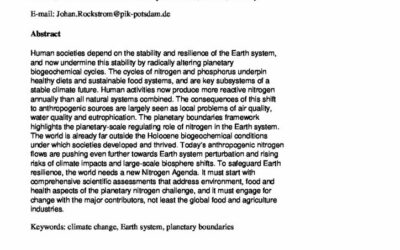









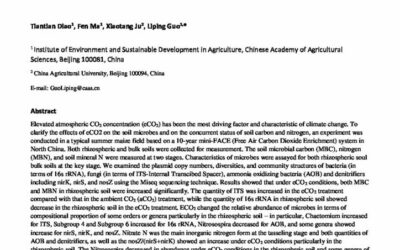





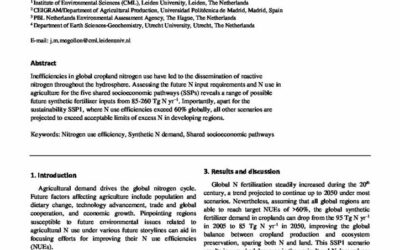













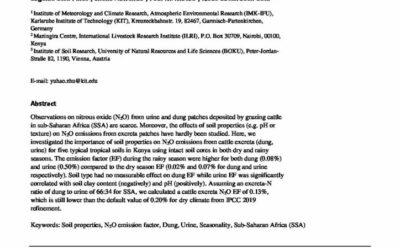
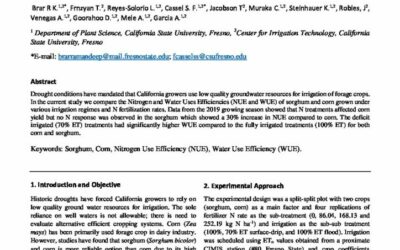
![Delayed N timing for maize reduced N2O emissions and drainage [NO3 – ] while increasing yield](https://ini2021.com/wp-content/uploads/2021/05/328_Scharf_Delayed-N-timing-for-maize-reduced-N2O-emissions-and-drainage-NO3-while-increasing-yield-pdf-724x1024-1-400x250.jpg)






